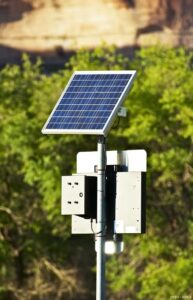During long and hot summers, solar panels are often exposed to high temperatures.
How hot is a solar panel actually?
Household solar panels are tested at 25 ° C (77 ° F), so the solar panel temperature is usually between 15 ° C and 35 ° C, during which time the solar cell will produce the maximum power generation efficiency. However, the temperature of solar panels may reach as high as 65 ° C (149 ° F), which hinders the efficiency of solar cells.
Most solar panels are composed of silicon photovoltaic (PV) cells, which are protected by glass panels and fixed to metal frames. These materials are similar to the materials that make up car windows and frames – to understand the heat of solar panels, think about cars parked in parking lots in hot summers. Windows and frames can be very hot to the touch, but there is almost no risk of fire.

The effect of temperature on the efficiency of solar panels
Users of solar panels often wonder, ‘Will solar panels overheat?’ Like any other electronic device, the performance of solar panels does indeed decrease with increasing temperature – the laws of thermodynamics tell us that as heat increases, power output decreases, which also applies to solar panels. Therefore, an increase in temperature means a decrease in the output of solar panels, which solar panel manufacturers refer to as the “temperature coefficient”.
Manufacturers evaluate the sensitivity of their products to temperature in the form of a temperature coefficient, expressed as a percentage per degree Celsius. For example, if the efficiency of solar panels is 17% and the temperature coefficient is -0.45, then for every 1 degree increase above 25 ° C, their efficiency will lose 0.45%. If the surface temperature of your roof rises to 30 ° C (86 ° F), the efficiency of solar panels will decrease to 16.7%. If it increases to 35 ° C (95 ° F), the efficiency will decrease to 16.3%.
How to offset solar panel overheating
No matter which type of panel is used, there will always be some power output lost due to heat. However, there are several ways to mitigate the impact of high temperatures on solar panels. The solar panel is also usually installed a few inches above the roof. In fact, there is airflow space below it, which helps to take the heat away from the solar module. One more thing, the temperature at which solar panels generate maximum conversion efficiency is 23 ° C.
If you want to know more about solar panels, please contact us, the solar panel manufacturer – Huanqi Technology (Shenzhen) Co., Ltd.




